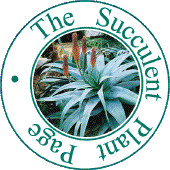 
Glossary of Botanical TermsTo locate the word in which you are interested:
|
A B C D E F G H I J K L M N O P Q R S T U V W X Y Z
Click on a letter to see definitions of all words beginning with that letter.F
F1 - of progeny derived from a first generation cross between distinct individuals.
F2 - of progeny from self fertile F1 hybrids.
Falcate - strongly curved or sickle-like.
Family - a taxonomic grouping of related genera with a similar floral pattern and other common characteristics, contained within an Order
Farina - a whitish mealy or flour-like covering. Hence adj. farinose, farinaceus.
Fasciation - malformation of a stem or other part usually with lateral flattening, cresting.
Fascicle - (Latin: fasciculus = small bundle) a small cluster or bundle of e.g. branches, flowers, leaves, or stems, or a bundle of vascular tissue. Of an inflorescence, a cluster of flowers in a leaf axil lacking an axis or cymose morphology. Hence adj. fasciculate: bundled or clustered.
See also: catkin, corymb, cyme, panicle, raceme, spadix, spike, thyrse umbel
Felt - a very thick layer of hairs or fibres.
Fertile - a plant with functional reproductive organs, producing pollen capable of fertilisation and seeds or spores capable of germination.
Fertiliser - a mix of essential nutrients supplied to plants to improve their growth or to correct a specific deficiency. For commercial fertilisers the proportions of Nitrogen:Phosphorous:Potassium are marked on the package as N:P:K ratios. More information.
Fibrous root - finely divided root system without obvious thickening or an enlarged central root.
Filament - stalk of a stamen supporting anther.
Flaccid - limp, flabby or drooping.
Flagellum - (Pl. flagella)- a whip-like hair, usually motile in lower plants and plankton. Hence adj. flagelliform = whip-like, flagellate = a single cell form of plankton with a flagellum.
Flavescens - becoming yellow.
Flavispina - with yellow spines.
Floccose - (of plants) having tufts of short soft woolly hairs.
Flora - all the plant species in an area. A book or treatise on plant species from a particular region.
Floral - relating to, or resembling, or made from, or containing flowers.
Floret - a small flower, especially as one component of a dense multiple flower cluster.
Flower - the complex reproductive organ of an angiosperm plant which may include sepals, petals, stamens and pistil. Flowers may include either male or female parts or both. The colourful parts of a flower and its perfume attract pollinators and guide them to the nectary, usually at the base of the flower tube. Pollination usually occurs incidentally to foraging for nectar or pollen as food. Xerophytic plants may have flowers that are produced and open in response to rain and produce seed within a few weeks of pollination, thus completing their life cycle. Species with tubular red flowers have often evolved to attract humming birds and other avian pollinators. Some night-flowering species have specialised to attract bats with foetid fleshy blooms or moths with large strongly-perfumed flowers.
See also: catkin, corymb, cyathium, cyme, fascicle, panicle, raceme, spadix, spike, thyrse umbel
Flower head - a dense arrangement of flowers arising from a common point as in e.g. Umbelliferae or Compositae.
Flowering plant - an angiosperm.
Foetid - with an offensive stinking odour.
Foliage - the leaves of plants.
Follicle - a dry dehiscent, many-seeded fruit derived from one carpel and splitting along one suture.
Forest - a plant community dominated by trees or other large plants e.g. large Aloes, Yuccas.
Form - the smallest degree of consistent differentiation between plants which may be formally named e.g. spine length or flower colour.
Fragilis - fragile, easily broken.
Fruit - the mature ripened reproductive body (ovary) of a seed plant which encloses the seed in fertile species of plant. True fruits develop from the ovary wall. See: pericarp. Many fungi, myxobacteria (slime moulds) and lichens produce a fruiting body, a macroscopic reproductive structure enclosing the spores. Fungal fruiting bodies often have distinctive sizes, shapes, and colours characteristic of each species.
See also: achene, apothecium, berry, capsule, caryopsis, drupe, pepo, pitahaya, pome, samara
Frutescens - shrubby.
Fulgida - glittering, shining.
Fulvous - yellow or tawny or yellow flecked with a mixture of grey or brown.
Fungus - (Pl. fungi)- simple spore-producing eukaryotic plants that obtain energy and nutrients by breaking down other organic material and abrorbing it through their cell walls. The Kingdom Fungi includes yeasts, moulds, mildews, mushrooms, rusts, slime moulds, smuts, and toadstools.
Funicle - the stalk of an ovule or seed. The thread like tissue connecting the developing seed, via the hilum, to the fruit. (Latin: funiculus = little rope)
Furlong - English unit of length equal to 660 feet, 220 yards, 40 poles, 10 chains or one-eighth of an English mile (Metric: 201.168 meters). Literally a 'furrow long' from Old English furlang, the length of a single furrow that a horse could plough without stopping and hence the length of a medieval field. Still used in horse racing.
Furrowed - with parallel longitudinal grooves or channels.
Fuscous - dusky, blackish or a greyish-brown colour.
Fused - joined and growing together.



